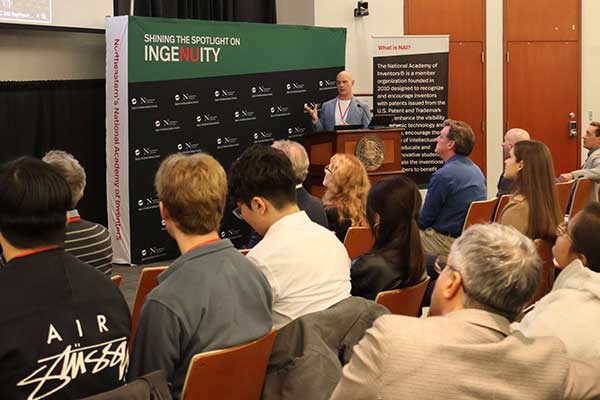Advancing Innovation and Impact: Highlights from the Northeastern NAI Chapter Fall 2025 Event

MIE Professor Randall Erb and ChE Associate Professor Steve Lustig both participated in the annual meeting of Northeastern University’s National Academy of Inventors (NAI) Chapter to bring together innovators, researchers, and entrepreneurs.
This article originally appeared on Northeastern’s Center for Research Innovation.
Northeastern University’s National Academy of Inventors (NAI) Chapter convened innovators, researchers, and entrepreneurs on October 29, 2025, for its annual Fall Meeting at the Egan Center’s Raytheon Amphitheater.
Hosted by the Center for Research Innovation (CRI), the event brought together faculty inventors, students, and industry experts to discuss how to translate scientific research into real-world impact and what it takes to determine if your innovation is VC-ready.
From Discovery to Commercialization: Turning Research Into Real-World Impact
Professor Randall Erb, Faculty Chair of the Northeastern NAI Chapter and Associate Chair for Research Affairs in the College of Engineering, opened the session by reaffirming the Chapter’s mission to recognize and empower inventors across all disciplines.
He emphasized that innovation thrives when mentorship, storytelling, and collaboration intersect. These are the core principles that drive the Northeastern NAI Chapter’s growth and success.
Professor Steve Lustig, Associate Professor of Chemical Engineering, followed by encouraging participants to step outside of academic silos and explore the commercialization process with curiosity and confidence.
“To be an innovator, you need to understand how to solve other people’s problems, get involved in the entire commercialization process, and know your strengths and weaknesses,” Lustig said.
He also emphasized that the commercialization process is easier than many people assume. “Trust me, the process is not as complicated as the work you’re already doing in STEM,” he remarked.
The Power of Storytelling in Innovation
Anne DiSante, NAI Ambassador and veteran of more than 35 years in technology transfer, was the first guest speaker, sharing insights from her career leading innovation programs across academia and industry. With more than three decades of experience guiding inventors, DiSante discussed the human side of the patenting and licensing world, highlighting how stories help connect inventions to investors, partners, and policymakers.
“Metrics don’t always show impact, so think about how to tell your story and work with resources like the CRI to tell your story well,” she told the audience. “If you don’t tell your story, someone else will fill the silence.”
DiSante highlighted the resources available through NAI institutional membership, including access to mentorship, educational programs, and a growing Chapter of Excellence network.
Her key message was that effective inventors also communicate the story behind their innovation, ensuring their ideas reach audiences who can amplify their impact.
What Makes a Technology Investable: An Investor’s Take
Next, Dr. Mike Fuerstman, Partner at Rhapsody Venture Partners, offered a candid investor’s view of the commercialization landscape.
Drawing from his experience funding and scaling hard-tech ventures, he reminded attendees that not every great idea is a viable business.
“Millions of inventions are created, and they might be amazing,” he said, “but most do not get licensed into commercial technology, and that’s OK. Only the inventions that solve a real, timely problem reach market success.”
Dr. Fuerstman outlined three questions every inventor should ask themselves (or their technology transfer office) honestly before pursuing commercialization:
- Does the technology solve a real problem people have today or are very likely to have in the near future?
- Is the technology differentiated enough to compete against other solutions in development?
- Are the techno-economics sound, meaning can it be produced and scaled profitably?
Dr. Fuerstman offered LiDAR as a cautionary example: despite years of hype and investment into countless startups, market demand and price barriers have prevented LiDAR technology from achieving widespread consumer use in self-driving cars. “It’s a reminder,” he said, “that even breakthrough science needs the right timing and economics to succeed.”
Storytelling: The Art Behind the Science
Mike Thomas, CEO of Appian Partners and Managing Partner at Bold Brain Capital, expanded on that theme, exploring the creative side of bringing technologies to market.
“Getting a patent issued is a great accomplishment, but millions of people around the world are inventing incredible things,” he said. “If you have a truly innovative invention, you can be creative in how you bring it to market. There’s a lot of art in how to take the science and deliver it to the marketplace in a unique way.”
Thomas discussed the three gauntlets every startup faces—leadership, market, and capital—and how resilience and emotional intelligence can be as valuable as technical skill.
He encouraged inventors to pursue business-model innovation and to become compelling storytellers: “We look for founders who build products customers can’t imagine living without.”
He illustrated this with a healthcare example: developing an at-home sleep-apnea device that required years of work with insurers to gain reimbursement and create a new market category so their product was actually viable.
The story underscored that success in innovation often hinges on patience, creativity, and persistence. It is not always about speed, but about staying the course, connecting with the right people, and believing in your invention.
Connection as Catalyst: Get Involved With Northeastern’s NAI Chapter
Following the keynote sessions, participants split into small-group discussions with both Fuerstman and Thomas to explore topics such as investment strategy, market validation, and partnership development. The event concluded with an open networking reception, where attendees continued conversations sparked during the breakout sessions.
Throughout the evening, a clear message emerged: successful innovation requires more than just great science. It demands collaboration, storytelling, and the courage to engage with markets, investors, and partners.
The Fall 2025 Meeting reflected Northeastern’s continued commitment to fostering an ecosystem where discovery meets impact. The Northeastern NAI Chapter invites faculty, researchers, and students to join its vibrant community of inventors.
Through networking events, mentorship programs, and recognition initiatives, members gain access to resources that support every stage of innovation. Together, Northeastern inventors are advancing research that inspires, impacts, and transforms the world.
Source: Center for Research Innovation